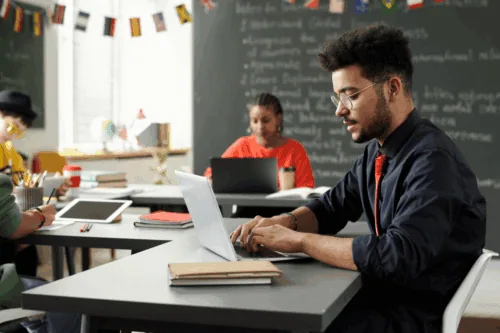Welcome to the essential guide for integrating inclusive practices in the classroom. As educators and future educators, embracing diversity and inclusion enriches our educational environments and prepares us to meet the varied needs of every student. This comprehensive guide outlines why inclusive practices are crucial and provide actionable strategies to implement them effectively in your classroom settings.
Why Focus on Inclusion?
In today’s global and diverse society, educating in a manner that respects and embraces diversity is more important than ever. Inclusive education isn’t just about meeting legal or ethical requirements; it’s about fostering a sense of belonging and offering every student the best chance to succeed.
This guide is designed to help you navigate the complexities of inclusive education. Whether you’re a seasoned educator looking to refine your approach or a new teacher aiming to build a solid foundation in inclusive practices, this resource is for you. Let’s explore how we can transform our classrooms into inclusive spaces where all students can learn and grow together.
Understanding Inclusive Practices in the Classroom
Inclusive classroom practices aim to create an environment where all students feel valued and supported, regardless of their backgrounds, abilities, or challenges. These practices are crucial in promoting equality and access to education for everyone. Understanding these practices helps educators create strategies that enhance learning for diverse student populations.
Core Components of Inclusive Practices
Several key components define inclusive practices in educational settings:
- Accessibility: Adjusting teaching methods and materials to ensure that all students can access learning content.
- Diversity: Reflecting a wide range of cultural, linguistic, and personal backgrounds in the educational content.
- Individualization: Tailoring education to meet the unique needs of each student, often involving personalized learning plans.
- Engagement: Fostering a classroom environment where every student is actively involved in learning processes.
Importance of Educator Awareness
For inclusive practices to be effectively implemented, educators must be deeply aware of the variations in student needs. This includes understanding different learning styles, physical and cognitive abilities, and cultural contexts. Training and continuous professional development can help teachers access opportunities for inclusion further in their teaching strategies.
External Support and Resources
Support for inclusive practices isn’t just confined to the classroom. Several external resources provide valuable guidance and tools for educators. For instance, the U.S. Department of Education offers insights and guidelines through its website, aiding teachers in creating more inclusive environments. Similarly, educational nonprofits often share best practices and research findings that can be incredibly beneficial. Engaging with these resources can enhance the effectiveness of inclusive educational approaches.
Incorporating inclusive practices in the classroom not only aids in fulfilling academic duties but also plays a significant role in shaping an empathetic, aware, and cohesive society.
Benefits of Inclusive Practices in Education
Adopting inclusive practices in the classroom not only supports individual students but also enriches the educational environment as a whole. These practices mold an atmosphere where every student can thrive, fostering both personal and academic growth.
Enhanced Student Engagement and Achievement
When classrooms embrace inclusivity, students often show increased engagement. They participate more actively in lessons, which can lead to:
- Better academic performance.
- Increased motivation to learn.
- Greater student satisfaction with the educational experience.
Social and Emotional Benefits
Inclusive classrooms promote understanding and respect among students from diverse backgrounds. Benefits include:
- Improved social skills.
- Enhanced empathy towards others.
- Reduced instances of bullying and isolation.
Benefits for Educators
Teachers working in inclusive environments often experience professional growth and satisfaction. They gain:
- New teaching strategies, enhancing their instructional methods.
- A deeper understanding of diversity and inclusion.
Long-Term Societal Impact
Schools contribute to a broader societal impact by instilling inclusive values in students. Educated in an environment of fairness and inclusion, students will likely carry these values into adulthood, influencing positive changes in their communities and workplaces.
Key Strategies to Implement Inclusive Practices
Implementing inclusive practices in the classroom is vital for fostering a supportive educational environment. Here are practical steps educators can take to ensure all students feel included and valued.
Inclusive Classroom Environment
Create a classroom layout that accommodates all students. Ensure:
- Seating arrangements cater to different physical needs.
- Materials are within easy reach for everyone.
- There is ample space for mobility aids if needed.
Foster an Inclusive Culture
Developing classroom rules with student input promotes ownership and respect. Celebrate diverse holidays and events to educate and honor different cultures and lifestyles. This approach promotes an understanding and appreciation of diversity, which is crucial for inclusive practices.
By integrating these strategies, educators can significantly enhance inclusive practices in the classroom, ensuring every student has the opportunity to succeed. Thus, these methods are not just about meeting needs but about enriching the educational experience for everyone involved.
Examples of Inclusive Practices in Action
Seeing inclusive practices in action can help illustrate their impact. Here are examples from schools that have successfully integrated inclusivity into their classrooms.
Case Study: Multisensory Learning Environments
One elementary school introduced multisensory learning stations where students can engage with content through touch, sight, sound, and movement. This approach has proven particularly effective for students with different learning abilities, ensuring that everyone can grasp the lessons in a way that suits them best.
Peer Tutoring Programs
Another method involves students helping each other in structured peer tutoring sessions. Here, students of all backgrounds and abilities collaborate, fostering mutual understanding and respect. This helps not only academically but also socially, as students build bonds across diverse lines.
Flexible Assessment Strategies
In some high schools, teachers have begun to implement flexible assessment strategies. Students can choose how they demonstrate their understanding of a topic, whether through written reports, oral presentations, or creative projects. This flexibility allows students to play to their strengths and engage more deeply with the material.
These real-world applications underscore the effectiveness of inclusive practices in the classroom. They show how varied approaches can meet the diverse needs of students, ultimately contributing to a more equitable educational experience.
Challenges and Solutions
While the benefits of inclusive practices in the classroom are clear, implementing them comes with challenges. Here’s how educators can address these hurdles effectively.
Resistance to Change
Some educators and institutions may resist changing traditional methods. Solutions include:
- Providing comprehensive training on the benefits and methods of inclusivity.
- Sharing success stories and data from schools that have embraced inclusivity.
Limited Resources
Schools often face resource constraints, making it tough to implement inclusive practices. Effective strategies might be:
- Seeking grants and funding from educational departments and private foundations dedicated to educational diversity.
- Using technology to create cost-effective, inclusive learning tools.
Diverse Student Needs
Every student is unique, requiring personalized approaches, which can be overwhelming. To manage this, schools can:
- Implement an Individualized Education Program (IEP) for students needing specific accommodations.
- Encourage collaboration among teachers to share strategies and insights.
Assessment of Inclusivity Efforts
Measuring the effectiveness of inclusivity initiatives can be challenging. Schools can:
- Use student feedback and performance metrics to gauge the impact of inclusive practices.
- Adjust strategies based on regular evaluations to improve the learning environment continuously.
Facing these challenges head-on allows for developing more robust and effective inclusive strategies, ensuring that all students benefit from equal access to education.
Resources for Further Learning
Expanding one’s knowledge and applying inclusive practices in the classroom is essential for any educator committed to creating an equitable learning environment. Several resources can help deepen understanding and skills in this area.
Professional Development Workshops
Educational organizations and universities often offer workshops on inclusive education. These sessions could be invaluable for teachers who want to implement effective inclusive strategies.
Online Courses and Certifications
Several online platforms provide courses that specialize in inclusive education methods. These courses offer flexibility and depth, allowing educators to learn independently while gaining certified skills.
Educational Literature and Journals
It is vital to keep up with the latest research in inclusive education. Journals like the Journal of Inclusive Education provide insights into new methods and studies on effective practices.
Networking with Other Educators
Joining forums and educational groups can allow educators to exchange ideas and experiences with peers working to enhance inclusivity in their classrooms.
Utilizing these resources not only supports personal and professional growth but also significantly contributes to the enhancement of inclusive practices in the classroom. Engaging with a community and continual learning are key to making sustained progress.
External Insights on Inclusive Practices
External perspectives can provide valuable insights into the classroom implementation and benefits of inclusive practices. Here’s how external expertise plays a crucial role in shaping effective educational strategies.
Academic Research
Universities and educational research centers continuously explore new aspects of inclusivity. Their findings are published in scholarly articles that discuss the long-term benefits and challenges of inclusive education systems.
Non-Governmental Organizations (NGOs)
NGOs dedicated to educational equity provide resources, training, and advocacy for inclusive practices. Organizations like the National Center for Learning Disabilities offer workshops and materials that help schools implement more effective inclusivity strategies.
International Examples
Looking at how other countries implement inclusive education can offer fresh perspectives and innovative ideas. Such cross-cultural insights can inspire improvements and adaptations in local contexts.
FAQs on Inclusive Practices in the Classroom
Integrating inclusive practices in the classroom raises several common questions among educators. Here are responses to some frequently asked queries.
What are the first steps to creating an inclusive classroom?
Start by assessing current practices and areas for improvement. Then, engage in training on inclusivity and diversity.
How can I tailor lessons to different learning styles?
Diversify teaching methods by incorporating visual aids, hands-on activities, and interactive discussions to accommodate various learners.
What if I face resistance from other staff or parents?
Communicate the benefits of inclusive practices clearly. Share research and success stories to illustrate their effectiveness.
How do I measure the success of inclusivity initiatives?
Gather feedback from students and parents, monitor academic and social progress, and adjust methods as needed to improve outcomes.
What resources are available for continued learning on inclusivity?
Look for books, online courses, and professional development workshops that provide ongoing support and information.
Addressing these questions can help foster more successful implementation of inclusive practices in the classroom, enhancing education for all students.
Conclusion
Inclusive classroom practices are essential for fostering an educational environment that supports all students and allows them to thrive academically and socially. By understanding and implementing these practices, educators can help ensure that every student has access to the resources they need to succeed, regardless of their background or abilities.
Take Action
For those who are committed to minimizing educational disparities and maximizing student achievements, joining an organization that supports these values can also be a powerful step. Consider joining Diversity Employment to connect with like-minded professionals and access diversity jobs, additional resources and support to make your educational environment as inclusive as possible.
By making a commitment to inclusivity, we can all contribute to a more equitable society, starting within our own classrooms.




